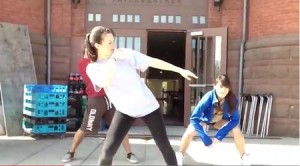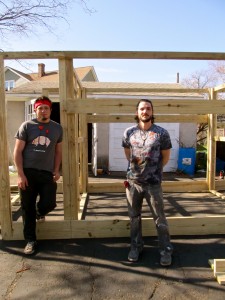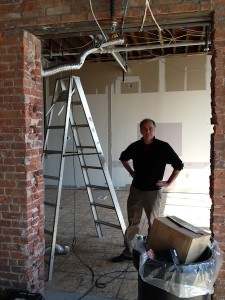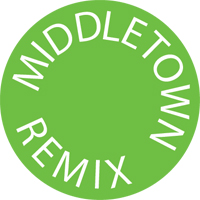Creative Campus Intern Sewon Kang ’14 discusses the intensives that have been part of the Creative Campus course “Blood, Muscle, Bone: The Anatomy of Wealth and Poverty,” as well as the free “Blood, Muscle, Bone” Performative Teach-In which will be held on Monday, November 11, 2013 from 7pm to 11pm in Fayerweather Beckham Hall. (The doors will open every 30 minutes—come and stay as long as you like.)

Having recently emerged from the “Blood, Muscle, Bone” intensives, adjusting to the rhythm of school again is almost like switching brains. For five days, I employed a radically different mode of thinking and processing than I ever have before. I moved, thought, and felt about many different issues surrounding wealth, poverty, and the body, and collaborated with my instructors and fellow students in surprising and new ways.
Our first few intensives were committed to the creation of a collective toolbox. Our guest instructors, Professors William Arsenio, Wendy Rayack, and Lois Brown, gave lectures related to wealth and poverty through the lens of their particular fields. From recent fiscal and experimental data, to the days of early American slave trading, the range of information presented to us walked us through an issue that transcends time and place, and affects all humans.
While listening to these lectures, Liz, Jawole, and their associates Vincent Thomas and Keith Thompson encouraged us to take on the role of the artist in addition to the role of the student. While listening, we posed questions and problematized the information, but we were also challenged to explore the information in ways that we would not necessarily have the freedom to do in other classrooms. We paid attention and took note of the visualizations and soundtracks floating through our heads, and responded to the lecturer’s body language and cues with our own bodies. Such prompts helped me realize that there are hundreds of angles from which this issue could be addressed which got me excited to further develop some of them with my classmates.
The lectures were punctuated by creative exercises and movement studies designed to give us more tools for our arsenal. The artists devised activities that allowed us to explore deeper and respond to what we learned with our thoughts and emotions. I was able to use my intellect and my body in combination to process the weight of the information. Wealth disparity in the U.S. is at an all time high; the richest 400 individuals are worth $2.02 trillion dollars, more than the net worth of the bottom 50% of the population. The immediacy of creative opportunities to process and react to such information was incredibly beneficial for me, as it’s sometimes difficult to take in facts, figures, and histories without taking into consideration their humanity and reality. There was an amazing collaboration between the artists and guests lecturers, allowing us to experiment and process with total freedom and comfort that I deeply appreciated.
I find the prospect of communicating and translating my ideas into movement a bit daunting, but mostly thrilling. Throughout the remainder of the intensive, Jawole, Liz, Vincent, and Keith had us create in small groups within limited timeframes. Working like this helped me get more comfortable with the act of communicating my ideas in an artistic way. I also got a taste for how creative and talented my peers are, and am excited to see what I can learn from working closely with them.
At one point, we all sat around in a circle and conducted an “asset inventory.” Everyone in the room shared a skill or an aspect about themselves that makes a contribution to the community, and the diversity of responses and experiences in the class opened up so many possibilities. I shared that I love to backpack and that I enjoy the challenge of carrying everything I need to survive on the strength of my own back. Using this idea as a metaphor, a small group of students and I got together to figure out how to create a backpack for change and reported back to the group. We created a movement piece that reflects on the meaning of carrying and sharing weight, and the necessity of being prepared for the tough times ahead. Since then, we’ve been workshopping the piece with Keith and other students who have joined in on the process. I’m really looking forward to where it will all go from here.
My fellow students and I have explored a lot of difficult problems and ideas in this course, some of which really hit home. We’re continuing to process the material creatively through songwriting, photography, and movement among other things. We’re currently honing in on ways to articulate what we’ve learned to a wider audience. As concerned citizens who are deeply disturbed by these inequities, we’re finding ways to express how to respond both personally and intellectually to the fact that there is something seriously wrong here. We’ve become witness to these problems in our country and are determined to do something about it. We’re carrying this heavy reality on our backs. We’re trying to deal with the weight of what it all means.
Our efforts will culminate in a special performance-based teach-in that will take place on Monday, November 11, 2013 from 7pm to 11pm every half hour in Fayerweather Beckham Hall. This teach-in is inspired by the activist movements that came before us, which emphasized the importance and need for knowledge first. This experiential event is going to be multifaceted, with elements that enlighten, shock, and ask the audience to participate and think with us. We’re going to use our bodies and various art forms to demonstrate the physicality of these issues to make issues of disparity tangible. We’ll invite participants to move, feel, explore and engage in dialogue with us, because the only way we can address these issues is to do it together.











